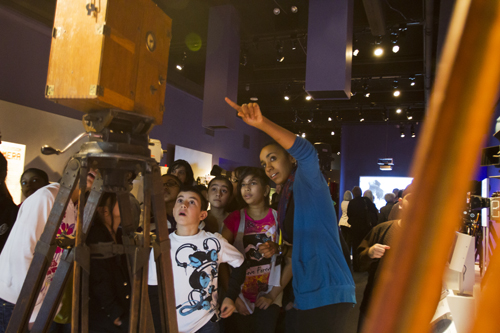
حصہ 1 فلم سیریز میں تعلیم کی
گزشتہ سال, آسٹریا میں چلتی امیج کا میوزیم, نیو یارک نے دیکھا 50,000 طلباء اور 5,000 سے اساتذہ 13 مختلف ریاستوں اور 12 مختلف ممالک اس کے دروازوں سے گزرتے ہیں — an increase of nearly three times in school group attendance since 2001.
While the Museum of the Moving Image (the only museum in the United States dedicated to exploring the art, history and technology of the moving image) believes the growth can be accredited to its rapid expansion and innovative, cutting edge programming, it also believes the 21st century technology revolution has substantially increased public awareness of moving images and interest in creating them. The result is that more educators want to include film as part of an arts curriculum.
Some 95 percent of teens, 12-17, use the Internet, according to a survey conducted by the Pew Research Center’s Internet & American Life Project میں 2011. In that study, 27 percent of teens, 12-17, record and upload video to the Internet. A major difference between this study and one conducted in 2006 is that online girls are just as likely these days to upload video as online boys. A sample of high school students I spoke with all knew what a green screen is, and many confirmed to me they have used the relatively inexpensive software now available to create, enhance and manipulate images. Digital tools have revolutionized the way kids express themselves and the way movies are now being made. “آج, many kids are editing videos on their mobile devices,” explains Christopher Wisniewski, Deputy Director for Education at the Museum of the Moving Image. “They understand the concept. They don’t necessarily understand why a professional editor might cut away from a scene at a certain point, or change the pace of his or her edits, or use a specific transition. تیزی, the goal is to bridge the gap between a basic knowledge of the tools and process to a richer understanding of how each decision made affects the product — and the audience.”
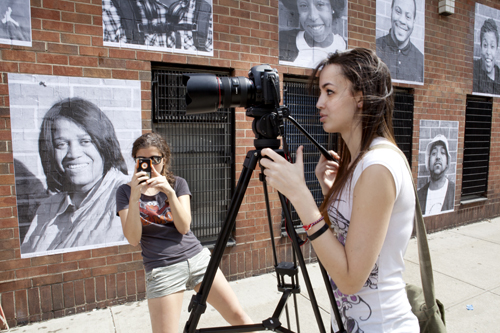
اکتوبر میں 2009, a partnership between Mayor Bloomberg’s office of Media and Entertainment and Tribeca Films resulted in the creation of the first Blueprint for Teaching and Learning in the Arts: The Moving Image. According to the Department of Education, one hundred teachers representing about 60 schools with a range of film and media programs have since participated in the Moving Image Blueprint training and support. The schools represent grades pre-kindergarten to 12, as well as special needs schools. I asked Beth Janson, Executive Director of the Tribeca Film Institute, پال بادشاہ, Executive Director of the Department of Education’s Office of the Arts and Special Projects, and Chris Wisniewski, Deputy Director for Education at the Museum of the Moving Image, to share their insights, including some of the challenges they face when educating students in film.
بیت, what do you want children to gain from a moving image education?
The Tribeca Film Institute (TFI) youth education programs give students the knowledge and tools to create works of art through storytelling – transforming them from passive consumers of media to thoughtful creators and designers of it. With the rapid shift of technology, students often arrive at school as informal media producers through various Internet channels and daily engagement with computers and mobile devices. Knowing this, we challenge our students to re-examine how they think about the media messages they are confronted with every day, and in the process, create learning experiences that can bridge social and cultural differences, and create a sense of community among students. Moving image education is also essential in preparing students for career and college readiness, and we hope to help students develop a fluency in technology skills that will be paramount to their future success.
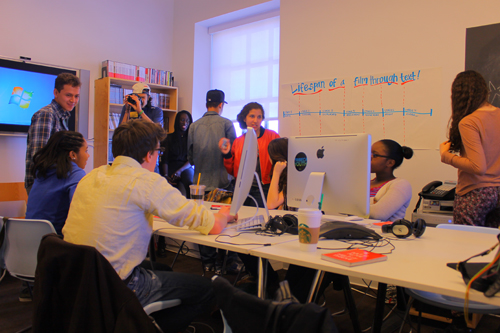
What were the key elements built into the curriculum?
The Blueprint curriculum was not developed to provide step-by-step instruction, but rather to provide developmental guidelines, suggested learning experiences and resources that will allow teachers to customize these concepts to their classroom’s skill level, interests and available materials.
How are students assessed in this curriculum?
Both students and teachers are asked to complete pre and post-program assessments that measure improvements in critical thinking, مواصلات, teamwork and skills gained. Perhaps the best measure of success for many of these programs are the students’ final projects – they really demonstrate how well students are grasping concepts and making the stories their own.
What is your vision for ongoing film education in educational institutions in the next 5 کرنے کے لئے 10 سال?
TFI sees the role of film expanding and heightening in purpose and scope. In addition to traditional filmmaking models, as the Internet’s importance increases in student’s lives, there will be a shift towards producing for web spaces and teaching new media skills, including coding and programming. This fall, TFI is piloting three programs that integrate this technology with filmmaking at the elementary, middle and high school levels.
اس کے علاوہ, filmmaking as a medium is expanding in its accessibility through smart phones, and computer-based and Internet-based production tools. Harnessing this student interest and widespread availability of technology, TFI is piloting programs in informal learning spaces in order to meet students outside of the traditional learning track. These spaces include correctional facilities, transfer schools and community organizations, making the instruction of film and new media available to all students, regardless of life circumstance, academic prowess and economic conditions.
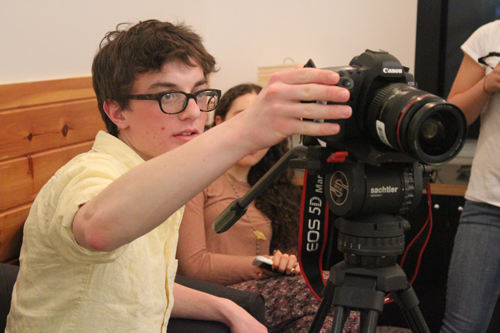
کرس, a changing curriculum requires professional development for teachers in the education system. How has the Museum of the Moving Image contributed to teacher training?
Teacher training has been an essential aspect of what we have done since the Museum’s founding. Outside of media education programs, few teachers have formal training in media production or media studies, but they realize how powerful a tool the moving image can be for teaching and learning. For over twenty years, we have been helping teachers across curricular areas to build the comfort level and expertise they need to bring the moving image into their classrooms.
I also suspect that because young people are so savvy when it comes to media and technology, their teachers might worry about using media in class. It can be quite unsettling for teachers to feel that their students are more adept and have a deeper skill set than they do, so that confidence building is an important part of teacher training.
With the rollout of the Blueprint, we have three teacher training workshops for media instructors. Those workshops were a part of a series that has been developed in collaboration with the Department of Education (DOE), TFI, the Mayor’s Office for Media and Entertainment, and other cultural partners. It’s important for us at the Museum to make certain that the cohort of educators working to adopt the Blueprint knows about the Museum and its resources, and to help create a forum where educators can share their ideas with one another. Educators are often looking for more technical training, but in these workshops, we have tried to emphasize the broader pedagogical challenges of teaching young people how to make media, particularly in the classroom.
Paul, what is the Department of Education’s vision for a moving images program over the next 5 سال?
Given that students are increasing facile and familiar with media and creating their own media pieces, we want to provide teachers and school leaders with the content and expertise that they need to assist students to make informed decisions about their own work and the vast amounts of media they encounter.
Creation of original films and animation allows students to have a distinct and powerful voice that honors their own opinions and allows them to explore other points of view and cultures. We aim to assist them in doing this in a responsible and critical manner.
As media programs continue to be developed in New York City Department of Education schools, we will support school-based programs and cultural partners in this work with the goal of increased student media opportunities and ongoing training for teachers.
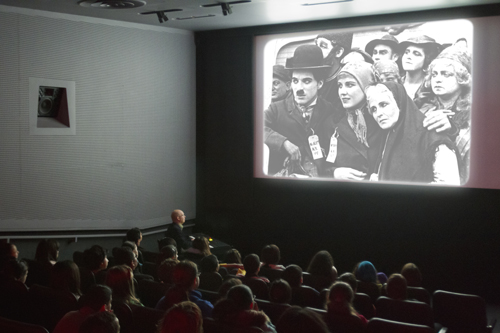
Photos courtesy of the Museum of the Moving Image and the Tribeca Film Institute.
فلم سیریز میں تعلیم میں مزید مضامین کے لیے: یہاں کلک کریں
میںn عالمی تلاش برائے تعلیم, سر مائیکل باربر سمیت میرے ساتھ اور عالمی سطح پر معروف فکری رہنماؤں (برطانیہ), ڈاکٹر. مائیکل بلاک (امریکہ), ڈاکٹر. لیون Botstein (امریکہ), پروفیسر مٹی Christensen کے (امریکہ), ڈاکٹر. لنڈا ڈارلنگ-ہیمنڈ (امریکہ), ڈاکٹر. مادھو چوہان (بھارت), پروفیسر مائیکل Fullan (کینیڈا), پروفیسر ہاورڈ گارڈنر (امریکہ), پروفیسر اینڈی Hargreaves نے (برطانیہ), پروفیسر کریں Yvonne ہلمین (نیدرلینڈ), پروفیسر کرسٹن Helstad (ناروے), جین Hendrickson نے (امریکہ), پروفیسر گلاب Hipkins (نیوزی لینڈ), پروفیسر Cornelia Hoogland (کینیڈا), مسز. چینٹل کوفمین (بیلجیم), ڈاکٹر. Eija Kauppinen (فن لینڈ), سٹیٹ سیکرٹری Tapio Kosunen (فن لینڈ), پروفیسر ڈومینک Lafontaine (بیلجیم), پروفیسر ہیو Lauder (برطانیہ), پروفیسر بین لیون (کینیڈا), پروفیسر بیری McGaw (آسٹریلیا), شیو ندار (بھارت), پروفیسر R. نٹراجن (بھارت), ڈاکٹر. PAK NG (سنگاپور), ڈاکٹر. ڈینس پوپ (امریکہ), شریدر رازگوپالن (بھارت), ڈاکٹر. ڈیانے Ravitch (امریکہ), سر کین رابنسن (برطانیہ), پروفیسر Pasi Sahlberg (فن لینڈ), Andreas کی Schleicher (پیسا, او ای سی ڈی), ڈاکٹر. انتھونی Seldon نے (برطانیہ), ڈاکٹر. ڈیوڈ Shaffer کے (امریکہ), ڈاکٹر. کرسٹن عمیق کر رہے ہیں (ناروے), چانسلر اسٹیفن Spahn (امریکہ), ایوز Theze (اسکول Français کی امریکی), پروفیسر چارلس Ungerleider (کینیڈا), پروفیسر ٹونی ویگنر (امریکہ), سر ڈیوڈ واٹسن (برطانیہ), پروفیسر Dylan کے Wiliam (برطانیہ), ڈاکٹر. مارک Wormald (برطانیہ), پروفیسر تیو Wubbels (نیدرلینڈ), پروفیسر مائیکل نوجوان (برطانیہ), اور پروفیسر Minxuan جانگ (چین) وہ تمام اقوام کو آج سامنا ہے کہ بڑی تصویر تعلیم سوالات دریافت کے طور پر. تعلیم کمیونٹی پیج کے لئے گلوبل تلاش
C. M. روبن وہ ایک موصول ہوئی ہے جس کے لئے دو بڑے پیمانے پر پڑھا سیریز کے مصنف ہے 2011 میں Upton سنکلیئر ایوارڈ, “تعلیم کے لئے گلوبل تلاش” اور “کس طرح پڑھیں گے?” انہوں نے تین bestselling کتابوں کے مصنف ہیں, سمیت Wonderland میں یلس اصلی.


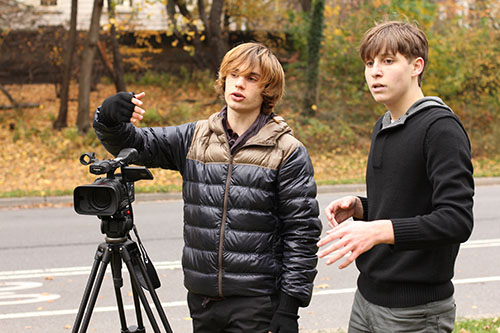
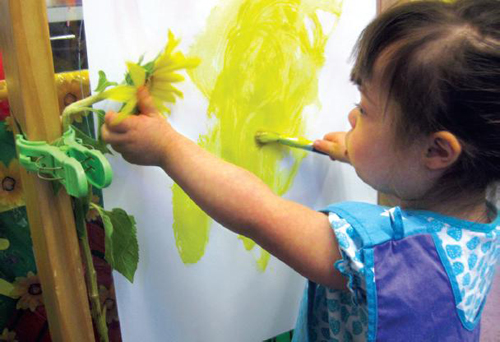
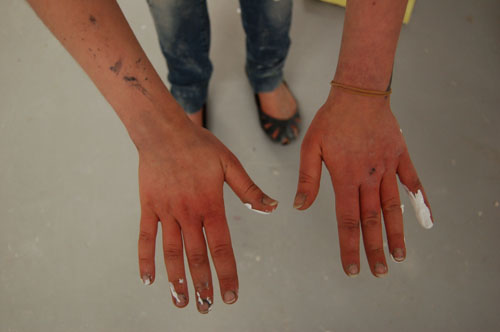
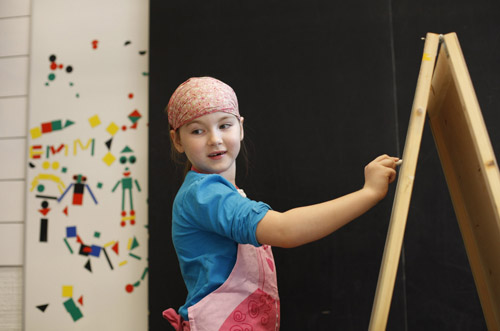
حالیہ تبصرے